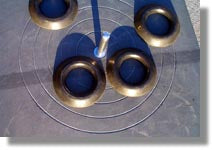No Products in the Cart
- (610) 597-0078
- Shappy's Quoit Outlet
One-on-one – You pitch from the same side of the boards when you travel to the opposing board. Non-diagonally. (see Rule 1 diagram).

Two-on-two (a.k.a. couples or doubles) – Your partner pitches from the diagonal side of the board (see Rule 2 diagram).

There are 4 quoits (2 for you and 2 for your partner).
Quoit Rules
Quoits can be played with two people, four people, or, if you want to practice, individually. Below is a list of all of the standard rules.
Starting A Game:
Determining The Score:
P1 P2
P2
P3 P4
P4
P5 P6
P6
P7 P8
P8